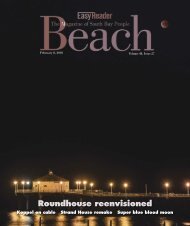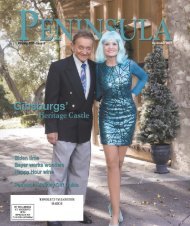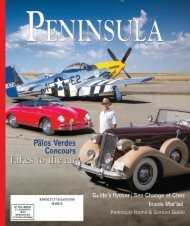Beach May 2018
Create successful ePaper yourself
Turn your PDF publications into a flip-book with our unique Google optimized e-Paper software.
trikeFord<br />
Otherwise known as<br />
weight-shift-control light sport aircraft because<br />
that’s how you steer them — by shifting your weight<br />
You’ve seen them buzzing along the beach like<br />
monstrous bees, or swooping low like Skittlescolored<br />
seagulls off the Manhattan <strong>Beach</strong><br />
Roundhouse. They look—and sound—like the unholy<br />
spawn of a hang glider and an industrial-strength leaf<br />
blower. Some people love these carefree, airborne symbols<br />
of freedom and fun. Others, not so much. As with<br />
many loud, brightly-colored adult toys, from Ducatis to<br />
Lamborghinis to jet skis, these tiny, open-air airplanes<br />
look incredible fun if you’re the one steering. For the<br />
rest of us, those of us staring up at all the noise and merriment,<br />
uninvited from the aerial fun-fest—well, your<br />
emotions may vary.<br />
But where do these things come from? Is there an airborne<br />
biker bar hidden somewhere on the industrial<br />
side of the 405? Is there a secret Batcave that houses<br />
these bat-like airplanes, presumably owned by a reclusive,<br />
wealthy thrill seeker, a kind of <strong>Beach</strong> Cities Bruce<br />
Wayne?<br />
A few seconds on Google provided some answers.<br />
These airplanes are flown by Pacific Blue Air, a flight<br />
school that specializes in what are called Weight-Shift-<br />
Control Light Sport Aircraft. From its base hangar at the<br />
Hawthorne Airport, just south of the 105 Freeway, Pacific<br />
Blue conducts introductory flight lessons that just<br />
happen to go over some of the most beautiful and interesting<br />
sites in Southern California. After the first,<br />
fun-oriented intro lesson, Pacific Blue can also take you<br />
all the way to earning a full Light Sport Pilot’s License,<br />
setting you loose to fly across the country if you want.<br />
G-Whizz<br />
They may look a little Backyard Buck Rogers at first<br />
sight, but these airplanes are FAA certified, exhaustively<br />
tested and rigorously engineered. Small single-engine<br />
airplanes, like routine Pipers and Cessnas, are typically<br />
built to withstand about three times the force of gravity<br />
— that is, to support three times their loaded weight.<br />
The LSA that Pacific Blue flies, the Evolution Revo, is<br />
designed and tested to twice that—6gs. So even though<br />
it may look like a combination of a lawn dart, espresso<br />
machine and bloated bobsled, it is very much a serious,<br />
civilized airplane.<br />
Instead of conventional controls, these trikes, as they<br />
are called in the business, are steered by the pilot adjusting<br />
the angle of the wing relative to the body of the<br />
plane hanging underneath. This method of control is<br />
older than the first airplane. The gliders that inspired<br />
the Wright brothers, flown by German pioneer Otto<br />
Lilienthal, were controlled this way, as are the thousands<br />
of unpowered hang gliders. Instead of a control<br />
yoke or a joystick, the pilot holds the bottom of a big<br />
aluminum triangle that is rigidly attached to the wing<br />
flying above, while the fuselage, complete with engine,<br />
pilot and passenger, actually dangles beneath like a<br />
plumb bob. It sounds sketchy, but it works.<br />
The Blueberry Sea Dragon<br />
Pacific Blue Air’s headquarters hangar is located just<br />
a couple hundred feet north of Elon Musk’s SpaceX<br />
compound. When I arrived, peeling off the 105 freeway,<br />
I saw a bizarre contraption touching down on the runway,<br />
a crazy-looking, blueberry-colored gyrocopter that<br />
looked like a cross between Barney the Dinosaur and a<br />
Leafy Sea Dragon from an aquarium shop. Sure<br />
enough, the madman who was flying it was going to be<br />
my own personal madman, errr, flight guide.<br />
Henry Boger, the company’s owner, is a Certified<br />
Flight Instructor, fully examined and licensed by the<br />
FAA. He has been flying for over 25 years. He’s fun,<br />
smart and warmly proficient, with the rare ability to<br />
teach without making learning feel like work. Since I’m<br />
already a licensed pilot, Henry cut to the chase, giving<br />
me a quick walk around our bright yellow Zonker of an<br />
airplane, setting me up with a flight suit and helmet,<br />
complete with headphones and microphone, and strapping<br />
me into the rear seat of the Revo. You don’t so<br />
much sit in a Revo as on it; my manly legs were soon<br />
wrapped tightly around Henry. Most Light Sport Aircraft<br />
flying is done from smaller, uncontrolled airfields,<br />
but Hawthorne is a bona-fide big boy airport, complete<br />
with business jets and an FAA control tower. Which<br />
meant that when Henry wasn’t chatting to me over the<br />
headphones and intercom, he was talking to Hawthorne<br />
tower as we taxied out, did our preflight checklist and<br />
engine run-up, and then, cleared for takeoff, trundled<br />
out onto the runway. The 5,000-foot runway at<br />
Hawthorne could be considered excessive for our purposes.<br />
Henry gunned the throttle of our 100-horsepower<br />
Rotax engine, and had our lightweight craft well into<br />
the air after only about 500 feet. “That’s Harrison Ford’s<br />
new hangar complex, for his airplane collection,” he<br />
said as we climbed over the runway, pointing out a massive<br />
3-hangar construction site on the northeast corner<br />
of the airport. Hawthorne Airport is right on the boundary<br />
of the LAX restricted airspace. It felt bizarre to be<br />
climbing in a vibrating, open-air June bug, humming<br />
over the gray expanse of the city, flying parallel to huge<br />
Airbus A380s descending into LAX just the other side<br />
of the 105 freeway.<br />
On Top of the World<br />
We climbed to a bit over 1,000 feet and set sail for the<br />
coast, the afternoon sun reddening as we flew. True to<br />
his instructor nature, Henry had me take the controls<br />
to get acclimated to flying this odd beast. If you’re an<br />
experienced pilot, everything you know is suddenly<br />
wrong. In a normal Cessna — or, for that matter, an F-
















